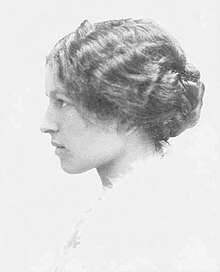
Back Наста Ройц Byelorussian Наста Ройц BE-X-OLD Nasta Rojc Croatian ნასტა როიცი Georgian Nasta Rojc Portuguese Ройц, Наста Russian Nasta Rojc Serbo-Croatian Nasta Rojc Serbian Наста Ройц Ukrainian
Nasta Rojc | |
|---|---|
 Portrait by Ludwig Grillich, before 1926 | |
| Born | Jerka Hermina Ljubica Rojc 6 November 1883 Bjelovar, Kingdom of Croatia-Slavonia, Austria-Hungary |
| Died | 6 November 1964 (aged 81) |
| Other names | Nasta Rojc-Šenoa |
| Occupation | Painter |
| Years active | 1909–1949 |
Jerka Hermina Ljubica Rojc (6 November 1883 – 6 November 1964), better known as Nasta Rojc, was a Croatian painter.
Born in Bjelovar, she was a sickly child and a misfit. She did not enjoy school or playing with other children, but liked both hunting and horse riding. After she declared in her youth that she was an atheist, her father had her educated in a convent school. Becoming depressed, she was sent to the seaside town of Kraljevica at fifteen, where she met a painter, Branko Šenoa, who inspired her to become an artist. Her father objected, but in exchange for her agreement to learn cooking, he allowed her to attend art school. She studied in Zagreb, Vienna, and Munich, learning to paint, sculpt, and engrave. When her father insisted she marry, Rojc who was a lesbian, entered a lavender marriage with Šenoa, after her father agreed to help her acquire a studio and assist with her living expenses.
From 1909 she exhibited works with the Croatian Art Society in Zagreb and was the first woman to have a solo exhibition at the Salon Ullrich. She participated in numerous exhibitions in the capitals of Eastern Europe until the onset of World War I. During the war she took commissions for portraits and worked on an autobiography. Around the same time, Rojc met a group of lesbians who had worked for the Scottish Women's Hospitals for Foreign Service during the war in Serbia and Sarajevo. After the war, the hospital personnel founded an orphanage in Bajina Bašta. One of them was a British peer, Alexandrina Onslow, who became Rojc's partner.
From 1923, they openly lived as a couple in a house Rojc had designed, which was shared with her husband until his death in 1939. Between 1924 and 1926, Rojc and Onslow lived in Scotland and England, where Rojc had a successful exhibition at the Gieves Art Gallery in London. Returning to Zagreb at the end of 1926, her work was derided by the critics. She exhibited with the Women's International Art Club in London until 1929, and was inspired to found the Klub likovnih umjetnica (Women Artists' Club) with Lina Virant Crnčić to promote the works of women artists. The group held eleven exhibitions between 1928 and 1940, in which she presented works of her own. When World War II broke out, the couple joined the resistance movement. They were reported to the Ustaše, arrested, sent to prison for several months in 1943, and were unable to reacquire their property until after the war ended. Rojc died in 1964, fourteen years after Onslow, with whom she was buried.
Rojc and her work were largely forgotten until the breakup of Yugoslavia. Almost immediately after Croatian independence a retrospective of her work was presented and scholars began evaluating Rojc's two autobiographies, her correspondence within her international lesbian network, and her photographic archive. It is rare that queer history in the region has had tangible documentation and the records that she left are seen as significant for both British and Yugoslavian lesbian history. Her paintings are held in many public and private collections including the Modern Gallery, Zagreb, the City Museum of Bjelovar, the Josip Kovačić Collection owned by the City of Zagreb, as well as the Croatian National Theater. In 2006 Rojc's likeness was featured on a postage stamp. Historian Leonida Kovač published a book analyzing Rojc's legacy in 2010, recognizing that it was innovative and pushed the boundaries of socio-cultural norms. Numerous retrospective exhibitions of her work have been held throughout Croatia; in 2017, fifty-three of her paintings were exhibited at the Palais Porcia, Vienna.